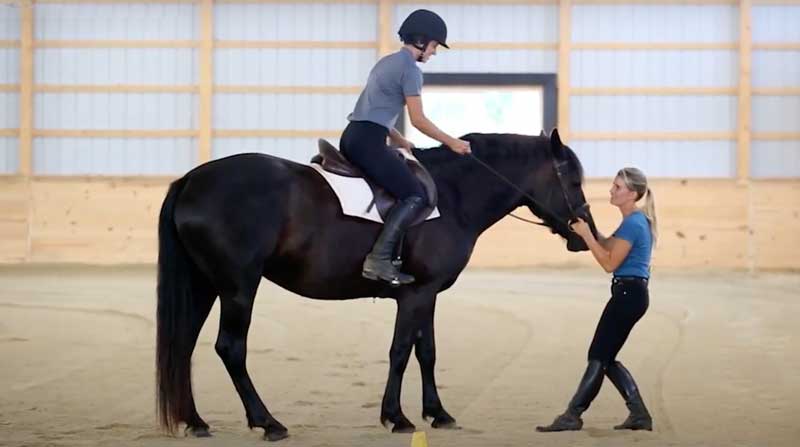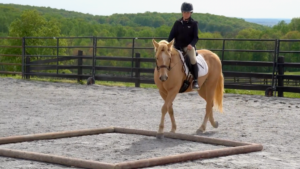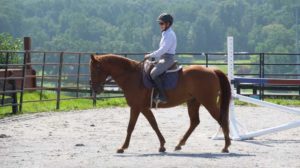Pull right, pull left. Kick to go.
We know guiding our horses is more subtle and nuanced than these simple instructions.
So how can we communicate to our horses where we want to go without just pulling at the bit?
And how can we signal a change in direction that instantly communicates to the horse where we want to go, while keeping us both perfectly in balance?
The key is balanced weight shifts, not leaning like you were on a motorcycle, and not even achieving the perfect combination of “put your inside leg here, your outside leg there”. The clearest communication for your horse is much more simple.
In this video, I will show you how to steer and guide your horse with a simple movement in your seat, and how you can practice this just walking on your own two feet!
P.S. This October, I will be offering an all new Balanced Riding Course. This course is not just about learning how to ride or train a horse, it is equally about learning how to see past the words that are used, to recognize what is really going on between a horse and person, and to choose what is best for you.
Stay tuned for more about the course + Free Training coming soon!
P.P.S. Hear from some of our Balanced Riding Course Alumni as they share their journey with horses, their highlights and their challenges – watch now!














27 Responses
I would love to learn how to train and ride again. I started riding in rodeo’s at 10 years of age clear up to 18 years from 4-H to Little Britches rodeo. I placed Queen twice in pleasure and speed, I would’ve loved to have made it to Pro but, then, well, life happened. I would absolutely love to get back in the saddle again and learn how to train from the horses back to training on the ground. Thank you.. Shelly Anderson.
Hi Shelly,
Wow! It sounds like you had a great time riding before and we would love to help you feel ready to get back in the saddle. Starting from the ground is one of the best ways to build connection, communication, and confidence with a horse before mounting up. Look forward to hearing how your journey back into the saddle goes.
Yorke
Hi Callie,
As always so helpful. I am going to try the thumb out in the direction of the turn. I am using your book of exercises when I ride outside of a lesson to work on a variety of skills. I am a rider of 4 years and older. It is all starting to come together and I see my horse be happier and happier as I become softer and more balanced.
Hi Catherine,
So wonderful to hear that the exercises from the book are helping you and your horse connect and become more balanced together. Keep up the good work!
Yorke
Thanks Callie! I liked your ending cycle moments about how to help a horse that drifts to the center. I hope I can remember – I think it was just a slight correction Bringing the outside shoulder back – I’ll watch that part again. I think I had been doing inside leg pressure, and worrying it might cause a lead change at the lope.
Hi DeAnna, Would love to hear how it goes for you!
Would love to hear how it goes for you!
If you can, download the video and bring it with you to the arena. You and your horse can watch together just before you get on.
Yorke
Very interesting to watch Ellie’s reactions in the first half of the video. Her ears, poll, and eye indicated her confusion. The differences at the end really illustrates how the incorrect aids can create stiffness/confusion and the soft following aids create a relaxed horse. Well done.
Thank you. I will ride with.my navel more!
Thank you. I have been working on this very thing. This is a wonderful reminder and visual. You make simple what could be complicated. Again, thank you.
I have been searching forever for a detailed video on steering. Thank you! I love the way you break things down. My challenge in steering precisely is communicating with the horse I ride about an upcoming turn so he is prepared, but without actually turning too early. When I want to turn off the track across the center to make an oval or circle, I am either telling him too early and we cut the circle too small or I am telling him too late and it isn’t smooth because he thinks we are going straight until last minute. I find it difficult to use cues to prepare him for the turn without actually turning and while posting and keeping a bend. My instructor does not teach open rein as way to turn your horse. Hands must be together and use my hips, seat, legs, and shoulders. I don’t know why this is so difficult for me!
Hi Kim,
It takes patient time and good practice to connect our whole body together through a change like a turn or transition. Remember that your horse is always learning with you, and as you progress you will both find better balance together through these changes.
Yorke
As said above, I have been working on this and tend to pull. I love your explanations and demonstrations.
Lily,
It’s a hard habit to break! And so common for a lot of us to do without meaning to. Hope this video helped!
Yorke
Thank you Calli. You make it so so easy to understand, even the simple things! Seat is such a powerful thing though it has to come with feel. And not everyone can feel (yet). The more you try and the more feedback you get from the horse,the more the feeling develops.
Yolanda,
Absolutely! The more you work on finding and developing feel, the more you and your horse will feel connected in the saddle.
Yorke
Decades ago I learned how to ride western, which until today still make more sense to me. There is no pulling on the horses mouth; to turn left just laying the reins on the right side of the neck and press with your right knee. The horse will move away from the pressure on it’s right side, turning to the left.
Phyllis,
You’re so right that Western riding is nicely intuitive that way! The same idea applies in other styles of riding when the whole body is working together to apply cues. In English riding, the inside is often directing while the outside is supporting. In this way, both sides work in harmony to create a channel for the horse to move through.
Yorke
Another really good video. I’ve been working on this recently so this is a great visual. Correcting the drift when going straight is something else I need to try.
Debbie,
The drift can be tricky especially on a young or green horse. One other thing you can try is intentionally working off leg yields as you come down the quarter line in the arena. Ride down the long way, yielding your horse to the left then as you approach the wall yield to the right until the center line and back, in a winding zig-zag pattern. This way you teach the horse when and how you will ask for “drift” so that when you’re cues are off the horse can better understand you are not asking for that movement. After practicing that movement a few times, see if you can ride down the long way straighter. Would love to hear, if you give it a try, how it goes!
Yorke
It’s amazing how horses will pick up on subtle cues one does unconsciously while riding. I know this will take a little time for both horse and rider to get this right.
I wish I had learned to ride correctly from the beginning. I want to do right by any horse I ride. There’s always room for improvement and something new to learn.
Thanks for the great instruction!
Diane,
Horses are so attuned to us and their surroundings. It really is amazing how they can seemingly read our minds and anticipate changes. And remember, every day is a chance to start new! Thanks for your response.
Yorke
I have really learned a lot from all your videos and I have two to go! you have such a good way of explaining in detail all the small details. Thank you so much!
Bonnie,
Thanks for the watches! So happy to hear the videos are valuable to you.
Yorke
With a young green horse how would you start this to get the response that you are after, do you start with rein pressure if your seat is not having the desired effect?
Hi Tanja,
With a young, green horse it is best to start with simple movements broken into parts. Then, you can gradually work up to the full movements. Check out this video on “teaching a young horse to turn”, here: https://www.youtube.com/watch?v=r3JLd2CjpU4
Hope this helps!
Yorke
This will help so much. I will try the thumb out. I will try to be more focused on the direction. So well explained.
I could not understand what Callie said at 9.34 min about thinking like ?Nemo? Sorry English is not my first language.
¡Hola!
Creemos que tu negocio encaja muy bien con esta propuesta.
Publicaremos tu empresa en más de 60 periódicos digitales de alta autoridad, lo que mejorará tu reputación, y posicionará tu web en las primeras posiciones de Internet.
Cuando tus clientes busquen información sobre ti, les generará más confianza ver que eres mencionado en periódicos digitales.
Y para que lo pruebes, te ofrecemos 2 meses completamente gratis.
¿Puedes facilitarme un número de contacto y lo comentamos?
Quedo a la espera de tu respuesta.
PD: Si no es de tu interés, puedes responder con “No estoy interesado”.